Impact of Communication on Health and Social Care Service Delivery
VerifiedAdded on 2020/01/15
|13
|4558
|2069
Report
AI Summary
This report comprehensively examines communication within health and social care settings. It begins by exploring relevant communication theories, such as psychoanalytic theory, and their application to real-world scenarios. The report then delves into the essential communication skills utilized in these contexts, including verbal, non-verbal, and written communication techniques, and how these techniques can be adapted for individuals with diverse needs. Furthermore, it addresses methods for handling inappropriate interpersonal communication, identifying barriers like misinterpretation and cultural insensitivity, and offering strategies to overcome them. The report also highlights the importance of strategies to support service users with specific communication needs, such as those with hearing or visual impairments, dementia, or autism, including the use of technology and translation services. Additionally, the influence of values and cultural factors on the communication process is discussed, emphasizing the importance of respecting diverse backgrounds. The impact of legislation, charters, and codes of practice, such as the Data Protection Act and the Access of Health Records Act, on communication is also examined. Finally, the report explores the use of Information and Communication Technology (ICT) in health and social care, including its benefits and legal considerations, providing a holistic view of effective communication practices within the field.

Communication
Paraphrase This Document
Need a fresh take? Get an instant paraphrase of this document with our AI Paraphraser
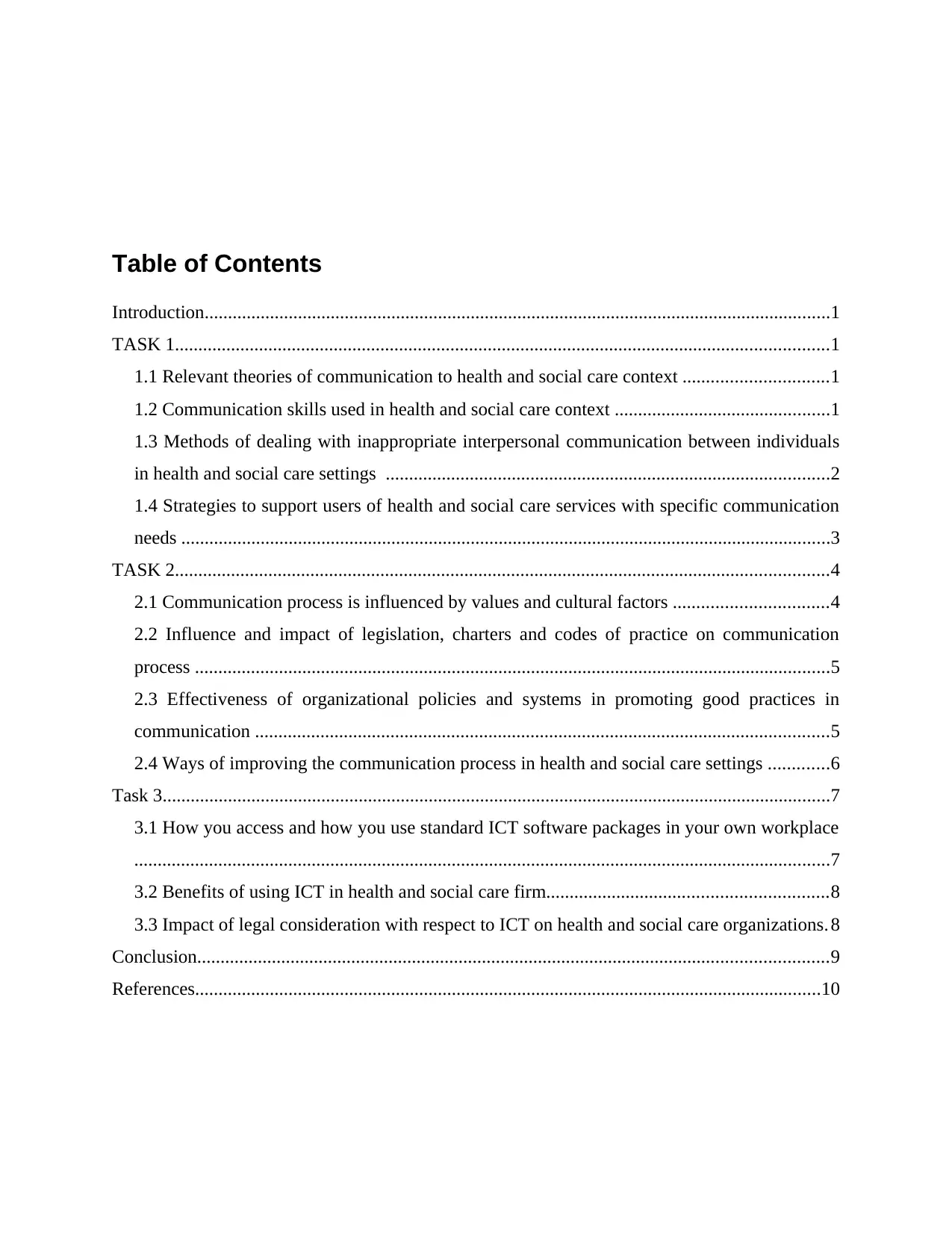
Table of Contents
Introduction......................................................................................................................................1
TASK 1............................................................................................................................................1
1.1 Relevant theories of communication to health and social care context ...............................1
1.2 Communication skills used in health and social care context ..............................................1
1.3 Methods of dealing with inappropriate interpersonal communication between individuals
in health and social care settings ...............................................................................................2
1.4 Strategies to support users of health and social care services with specific communication
needs ...........................................................................................................................................3
TASK 2............................................................................................................................................4
2.1 Communication process is influenced by values and cultural factors .................................4
2.2 Influence and impact of legislation, charters and codes of practice on communication
process ........................................................................................................................................5
2.3 Effectiveness of organizational policies and systems in promoting good practices in
communication ...........................................................................................................................5
2.4 Ways of improving the communication process in health and social care settings .............6
Task 3...............................................................................................................................................7
3.1 How you access and how you use standard ICT software packages in your own workplace
.....................................................................................................................................................7
3.2 Benefits of using ICT in health and social care firm............................................................8
3.3 Impact of legal consideration with respect to ICT on health and social care organizations. 8
Conclusion.......................................................................................................................................9
References......................................................................................................................................10
Introduction......................................................................................................................................1
TASK 1............................................................................................................................................1
1.1 Relevant theories of communication to health and social care context ...............................1
1.2 Communication skills used in health and social care context ..............................................1
1.3 Methods of dealing with inappropriate interpersonal communication between individuals
in health and social care settings ...............................................................................................2
1.4 Strategies to support users of health and social care services with specific communication
needs ...........................................................................................................................................3
TASK 2............................................................................................................................................4
2.1 Communication process is influenced by values and cultural factors .................................4
2.2 Influence and impact of legislation, charters and codes of practice on communication
process ........................................................................................................................................5
2.3 Effectiveness of organizational policies and systems in promoting good practices in
communication ...........................................................................................................................5
2.4 Ways of improving the communication process in health and social care settings .............6
Task 3...............................................................................................................................................7
3.1 How you access and how you use standard ICT software packages in your own workplace
.....................................................................................................................................................7
3.2 Benefits of using ICT in health and social care firm............................................................8
3.3 Impact of legal consideration with respect to ICT on health and social care organizations. 8
Conclusion.......................................................................................................................................9
References......................................................................................................................................10
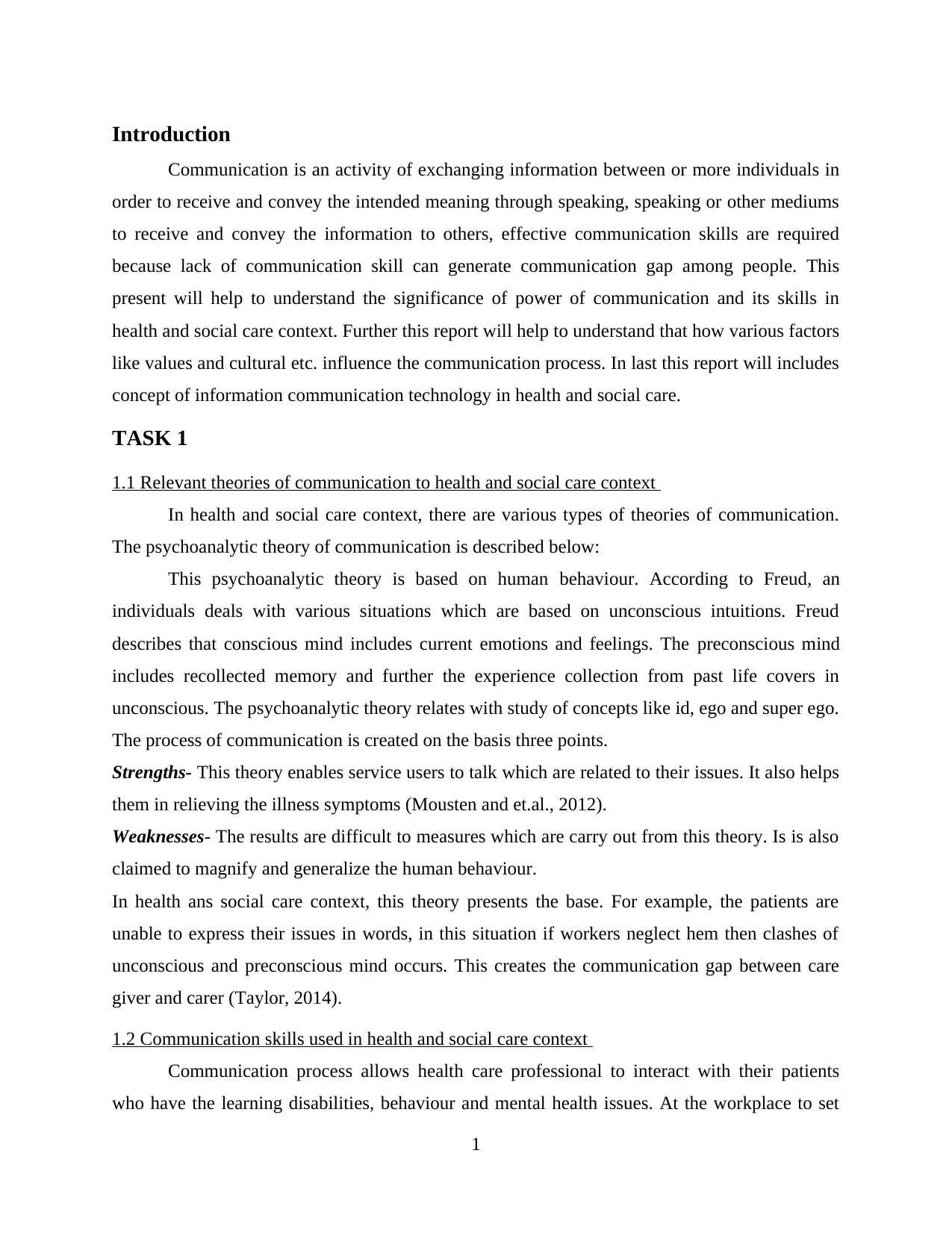
Introduction
Communication is an activity of exchanging information between or more individuals in
order to receive and convey the intended meaning through speaking, speaking or other mediums
to receive and convey the information to others, effective communication skills are required
because lack of communication skill can generate communication gap among people. This
present will help to understand the significance of power of communication and its skills in
health and social care context. Further this report will help to understand that how various factors
like values and cultural etc. influence the communication process. In last this report will includes
concept of information communication technology in health and social care.
TASK 1
1.1 Relevant theories of communication to health and social care context
In health and social care context, there are various types of theories of communication.
The psychoanalytic theory of communication is described below:
This psychoanalytic theory is based on human behaviour. According to Freud, an
individuals deals with various situations which are based on unconscious intuitions. Freud
describes that conscious mind includes current emotions and feelings. The preconscious mind
includes recollected memory and further the experience collection from past life covers in
unconscious. The psychoanalytic theory relates with study of concepts like id, ego and super ego.
The process of communication is created on the basis three points.
Strengths- This theory enables service users to talk which are related to their issues. It also helps
them in relieving the illness symptoms (Mousten and et.al., 2012).
Weaknesses- The results are difficult to measures which are carry out from this theory. Is is also
claimed to magnify and generalize the human behaviour.
In health ans social care context, this theory presents the base. For example, the patients are
unable to express their issues in words, in this situation if workers neglect hem then clashes of
unconscious and preconscious mind occurs. This creates the communication gap between care
giver and carer (Taylor, 2014).
1.2 Communication skills used in health and social care context
Communication process allows health care professional to interact with their patients
who have the learning disabilities, behaviour and mental health issues. At the workplace to set
1
Communication is an activity of exchanging information between or more individuals in
order to receive and convey the intended meaning through speaking, speaking or other mediums
to receive and convey the information to others, effective communication skills are required
because lack of communication skill can generate communication gap among people. This
present will help to understand the significance of power of communication and its skills in
health and social care context. Further this report will help to understand that how various factors
like values and cultural etc. influence the communication process. In last this report will includes
concept of information communication technology in health and social care.
TASK 1
1.1 Relevant theories of communication to health and social care context
In health and social care context, there are various types of theories of communication.
The psychoanalytic theory of communication is described below:
This psychoanalytic theory is based on human behaviour. According to Freud, an
individuals deals with various situations which are based on unconscious intuitions. Freud
describes that conscious mind includes current emotions and feelings. The preconscious mind
includes recollected memory and further the experience collection from past life covers in
unconscious. The psychoanalytic theory relates with study of concepts like id, ego and super ego.
The process of communication is created on the basis three points.
Strengths- This theory enables service users to talk which are related to their issues. It also helps
them in relieving the illness symptoms (Mousten and et.al., 2012).
Weaknesses- The results are difficult to measures which are carry out from this theory. Is is also
claimed to magnify and generalize the human behaviour.
In health ans social care context, this theory presents the base. For example, the patients are
unable to express their issues in words, in this situation if workers neglect hem then clashes of
unconscious and preconscious mind occurs. This creates the communication gap between care
giver and carer (Taylor, 2014).
1.2 Communication skills used in health and social care context
Communication process allows health care professional to interact with their patients
who have the learning disabilities, behaviour and mental health issues. At the workplace to set
1
⊘ This is a preview!⊘
Do you want full access?
Subscribe today to unlock all pages.

Trusted by 1+ million students worldwide

the communication with other service users and patients, the different techniques like verbal, non
verbal, gestures and sign language etc. could be used. According to given case scenario, the
inappropriate communication occurs between service users and staff members. The manager
believes that effective communication skills are essential to work in a care environment. For
solution of this problem, the techniques can be used which are discussed below:
Verbal communication- With the help of this technique information can be delivered to service
users by use of spoken words. By using the verbal communication technique through service
provider, the service user can receive the message. If a patient is hearing impaired then in this
situation service user can use lip reading technique to understand the words of service provider
(O’Halloran, Worrall and Hickson, 2012).
Non-verbal communication- In this technique, facial expressions and body languages are used
to convey the information. The staff members can do body movements, actions and gestures to
convey the message to the service users. The service users who have learning disabilities than
staff members can use the sign language in which they can use their hands for forming the
shapes. By using this technique, care taker can establish their communication with service users.
Written communication- To convey the message to service users, health care professional can
write the words or draw the image. With the help of this care workers can easily covey their
messages to service users.
The staff members of care home should be aware about these technique so if any patient
uses sign language or these above techniques then they will be able to understand their messages
like what they are trying to say (Desai and Pandya, 2013).
1.3 Methods of dealing with inappropriate interpersonal communication between individuals in
health and social care settings
The interpersonal communication basically arises from misinterpretation of body
languages, wrong use of vocabulary and cultural insensitivity etc. Generally inappropriate
interpersonal communication leads to the communication gap. The barriers causes the difficulty
in communication when the barriers are too strong. According to scenario new recruits uses
English language as second option which create communication gap among service users and
staff members. The misinterpretation, inappropriate language, breach of confidentiality, trust,
power and in-congruent messages etc. are the barriers of proper communication. All these
barriers creates the lack of communication between service provider and service users
2
verbal, gestures and sign language etc. could be used. According to given case scenario, the
inappropriate communication occurs between service users and staff members. The manager
believes that effective communication skills are essential to work in a care environment. For
solution of this problem, the techniques can be used which are discussed below:
Verbal communication- With the help of this technique information can be delivered to service
users by use of spoken words. By using the verbal communication technique through service
provider, the service user can receive the message. If a patient is hearing impaired then in this
situation service user can use lip reading technique to understand the words of service provider
(O’Halloran, Worrall and Hickson, 2012).
Non-verbal communication- In this technique, facial expressions and body languages are used
to convey the information. The staff members can do body movements, actions and gestures to
convey the message to the service users. The service users who have learning disabilities than
staff members can use the sign language in which they can use their hands for forming the
shapes. By using this technique, care taker can establish their communication with service users.
Written communication- To convey the message to service users, health care professional can
write the words or draw the image. With the help of this care workers can easily covey their
messages to service users.
The staff members of care home should be aware about these technique so if any patient
uses sign language or these above techniques then they will be able to understand their messages
like what they are trying to say (Desai and Pandya, 2013).
1.3 Methods of dealing with inappropriate interpersonal communication between individuals in
health and social care settings
The interpersonal communication basically arises from misinterpretation of body
languages, wrong use of vocabulary and cultural insensitivity etc. Generally inappropriate
interpersonal communication leads to the communication gap. The barriers causes the difficulty
in communication when the barriers are too strong. According to scenario new recruits uses
English language as second option which create communication gap among service users and
staff members. The misinterpretation, inappropriate language, breach of confidentiality, trust,
power and in-congruent messages etc. are the barriers of proper communication. All these
barriers creates the lack of communication between service provider and service users
2
Paraphrase This Document
Need a fresh take? Get an instant paraphrase of this document with our AI Paraphraser
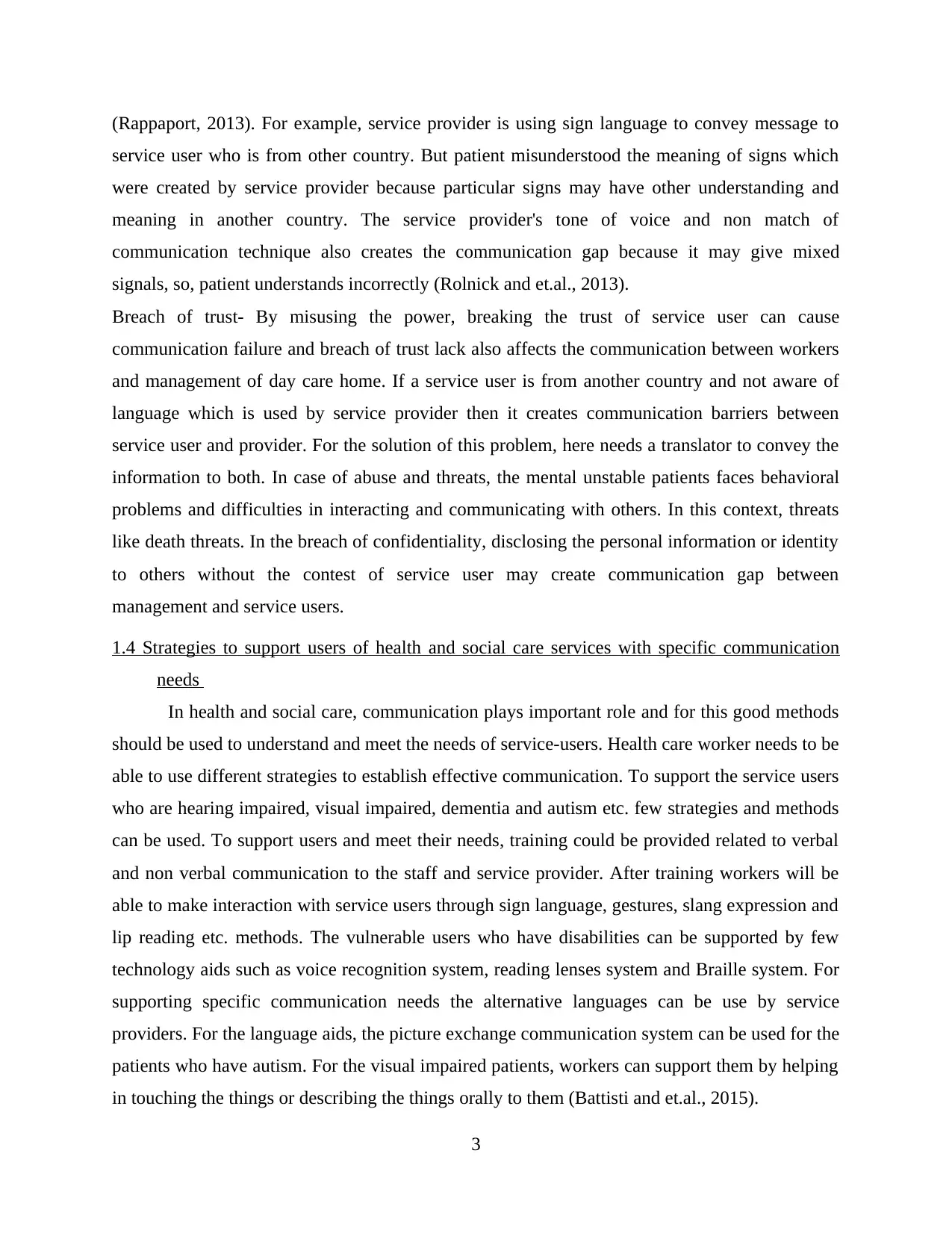
(Rappaport, 2013). For example, service provider is using sign language to convey message to
service user who is from other country. But patient misunderstood the meaning of signs which
were created by service provider because particular signs may have other understanding and
meaning in another country. The service provider's tone of voice and non match of
communication technique also creates the communication gap because it may give mixed
signals, so, patient understands incorrectly (Rolnick and et.al., 2013).
Breach of trust- By misusing the power, breaking the trust of service user can cause
communication failure and breach of trust lack also affects the communication between workers
and management of day care home. If a service user is from another country and not aware of
language which is used by service provider then it creates communication barriers between
service user and provider. For the solution of this problem, here needs a translator to convey the
information to both. In case of abuse and threats, the mental unstable patients faces behavioral
problems and difficulties in interacting and communicating with others. In this context, threats
like death threats. In the breach of confidentiality, disclosing the personal information or identity
to others without the contest of service user may create communication gap between
management and service users.
1.4 Strategies to support users of health and social care services with specific communication
needs
In health and social care, communication plays important role and for this good methods
should be used to understand and meet the needs of service-users. Health care worker needs to be
able to use different strategies to establish effective communication. To support the service users
who are hearing impaired, visual impaired, dementia and autism etc. few strategies and methods
can be used. To support users and meet their needs, training could be provided related to verbal
and non verbal communication to the staff and service provider. After training workers will be
able to make interaction with service users through sign language, gestures, slang expression and
lip reading etc. methods. The vulnerable users who have disabilities can be supported by few
technology aids such as voice recognition system, reading lenses system and Braille system. For
supporting specific communication needs the alternative languages can be use by service
providers. For the language aids, the picture exchange communication system can be used for the
patients who have autism. For the visual impaired patients, workers can support them by helping
in touching the things or describing the things orally to them (Battisti and et.al., 2015).
3
service user who is from other country. But patient misunderstood the meaning of signs which
were created by service provider because particular signs may have other understanding and
meaning in another country. The service provider's tone of voice and non match of
communication technique also creates the communication gap because it may give mixed
signals, so, patient understands incorrectly (Rolnick and et.al., 2013).
Breach of trust- By misusing the power, breaking the trust of service user can cause
communication failure and breach of trust lack also affects the communication between workers
and management of day care home. If a service user is from another country and not aware of
language which is used by service provider then it creates communication barriers between
service user and provider. For the solution of this problem, here needs a translator to convey the
information to both. In case of abuse and threats, the mental unstable patients faces behavioral
problems and difficulties in interacting and communicating with others. In this context, threats
like death threats. In the breach of confidentiality, disclosing the personal information or identity
to others without the contest of service user may create communication gap between
management and service users.
1.4 Strategies to support users of health and social care services with specific communication
needs
In health and social care, communication plays important role and for this good methods
should be used to understand and meet the needs of service-users. Health care worker needs to be
able to use different strategies to establish effective communication. To support the service users
who are hearing impaired, visual impaired, dementia and autism etc. few strategies and methods
can be used. To support users and meet their needs, training could be provided related to verbal
and non verbal communication to the staff and service provider. After training workers will be
able to make interaction with service users through sign language, gestures, slang expression and
lip reading etc. methods. The vulnerable users who have disabilities can be supported by few
technology aids such as voice recognition system, reading lenses system and Braille system. For
supporting specific communication needs the alternative languages can be use by service
providers. For the language aids, the picture exchange communication system can be used for the
patients who have autism. For the visual impaired patients, workers can support them by helping
in touching the things or describing the things orally to them (Battisti and et.al., 2015).
3
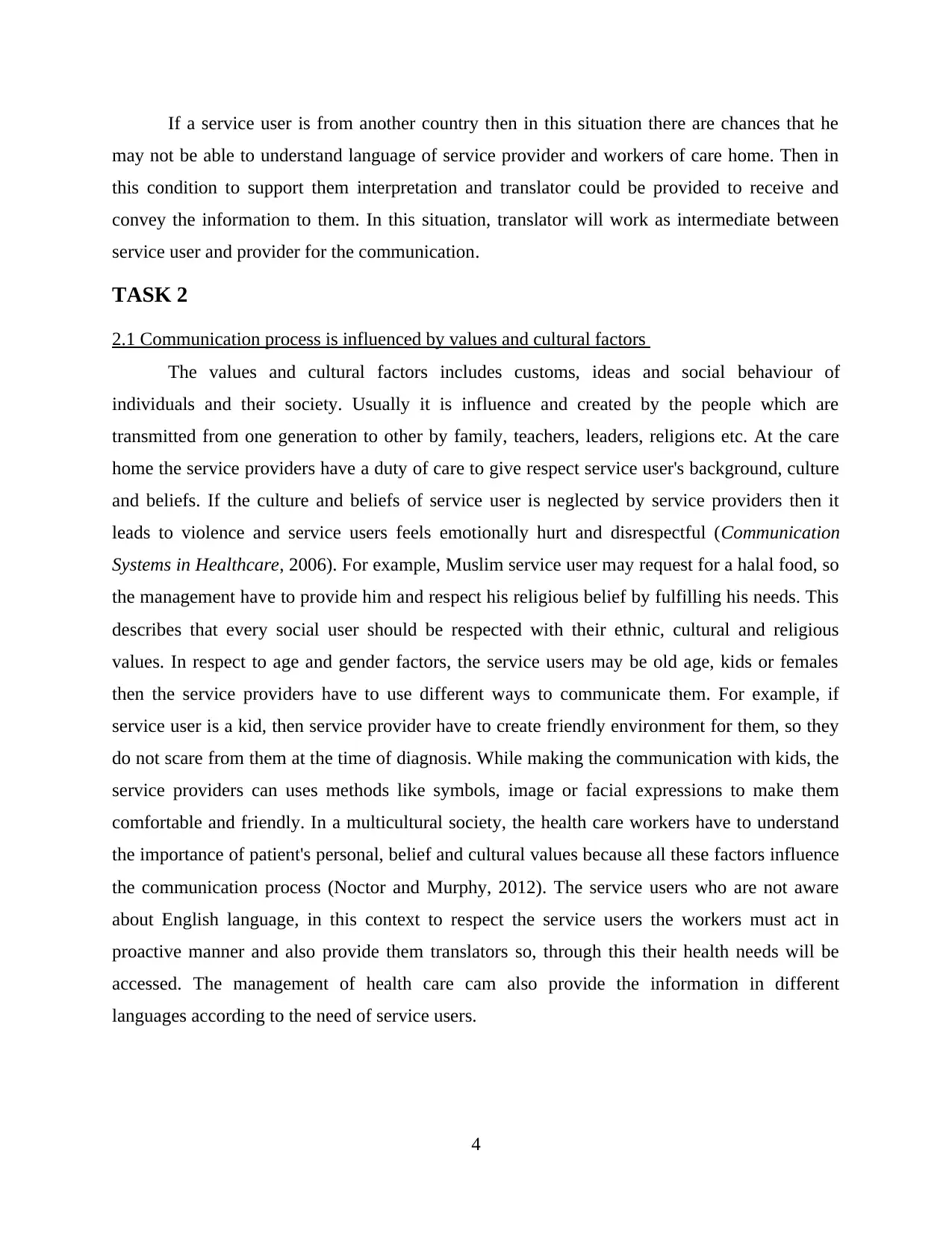
If a service user is from another country then in this situation there are chances that he
may not be able to understand language of service provider and workers of care home. Then in
this condition to support them interpretation and translator could be provided to receive and
convey the information to them. In this situation, translator will work as intermediate between
service user and provider for the communication.
TASK 2
2.1 Communication process is influenced by values and cultural factors
The values and cultural factors includes customs, ideas and social behaviour of
individuals and their society. Usually it is influence and created by the people which are
transmitted from one generation to other by family, teachers, leaders, religions etc. At the care
home the service providers have a duty of care to give respect service user's background, culture
and beliefs. If the culture and beliefs of service user is neglected by service providers then it
leads to violence and service users feels emotionally hurt and disrespectful (Communication
Systems in Healthcare, 2006). For example, Muslim service user may request for a halal food, so
the management have to provide him and respect his religious belief by fulfilling his needs. This
describes that every social user should be respected with their ethnic, cultural and religious
values. In respect to age and gender factors, the service users may be old age, kids or females
then the service providers have to use different ways to communicate them. For example, if
service user is a kid, then service provider have to create friendly environment for them, so they
do not scare from them at the time of diagnosis. While making the communication with kids, the
service providers can uses methods like symbols, image or facial expressions to make them
comfortable and friendly. In a multicultural society, the health care workers have to understand
the importance of patient's personal, belief and cultural values because all these factors influence
the communication process (Noctor and Murphy, 2012). The service users who are not aware
about English language, in this context to respect the service users the workers must act in
proactive manner and also provide them translators so, through this their health needs will be
accessed. The management of health care cam also provide the information in different
languages according to the need of service users.
4
may not be able to understand language of service provider and workers of care home. Then in
this condition to support them interpretation and translator could be provided to receive and
convey the information to them. In this situation, translator will work as intermediate between
service user and provider for the communication.
TASK 2
2.1 Communication process is influenced by values and cultural factors
The values and cultural factors includes customs, ideas and social behaviour of
individuals and their society. Usually it is influence and created by the people which are
transmitted from one generation to other by family, teachers, leaders, religions etc. At the care
home the service providers have a duty of care to give respect service user's background, culture
and beliefs. If the culture and beliefs of service user is neglected by service providers then it
leads to violence and service users feels emotionally hurt and disrespectful (Communication
Systems in Healthcare, 2006). For example, Muslim service user may request for a halal food, so
the management have to provide him and respect his religious belief by fulfilling his needs. This
describes that every social user should be respected with their ethnic, cultural and religious
values. In respect to age and gender factors, the service users may be old age, kids or females
then the service providers have to use different ways to communicate them. For example, if
service user is a kid, then service provider have to create friendly environment for them, so they
do not scare from them at the time of diagnosis. While making the communication with kids, the
service providers can uses methods like symbols, image or facial expressions to make them
comfortable and friendly. In a multicultural society, the health care workers have to understand
the importance of patient's personal, belief and cultural values because all these factors influence
the communication process (Noctor and Murphy, 2012). The service users who are not aware
about English language, in this context to respect the service users the workers must act in
proactive manner and also provide them translators so, through this their health needs will be
accessed. The management of health care cam also provide the information in different
languages according to the need of service users.
4
⊘ This is a preview!⊘
Do you want full access?
Subscribe today to unlock all pages.

Trusted by 1+ million students worldwide

2.2 Influence and impact of legislation, charters and codes of practice on communication process
The term legislation is group of laws which are made by government. Legislation
regulates that how individual live, improve their lives and also determines the framework of
policies. In this Data Protection Act 1998 is important part because it controls that how the
personal information of person will be use by organization and government. It ensures that
personal data is accessed and secures in responsible and controlled manner. In health and social
care context, the service users are more concern that there personal information is securely stored
or not. For the data protection, the whole process related to data storage and maintenance is done
in professional and mature manner. The confidentiality about data should be maintained because
information related to service users can not be disclosed to anyone with out the permission of
owner. If the dignity and privacy of service users are respected then it describes that human
rights are protected and achieved. Under the Access of Health Records Act 1990, the patients
have the rights to access their personal medical and health records (Shah and et.al., 2014). Health
care workers have to strictly follow the rules like data protection principles to use the data
confidentiality. The law of confidentiality describes that data in computer, visuals, paper or audio
form should not be disclosed to third party without patients contest. The six Caldicott principles
includes in codes of practice and it can applied to the handling service users identifiable
information. It justify that why patients information are shared like use and transfer of them. The
policies and legislation are implemented in the health care organization so that different gender,
age, cultural and religious background are not neglected in negative manner (Donovan, 2015).
2.3 Effectiveness of organizational policies and systems in promoting good practices in
communication
The good practices in communication contributes to build confidence, increase trust and
improves the service efficiency. An organization must have the systems to assure requirements
and principles of governance are systematically applied which helps to promote policies in
effective communication. The care home must have a system to assure both policies and codes of
practices to rum business operations effectively. The information strategy in organization is very
important to get appropriate information at the right time. The complaint channel of health and
social care organization should be design appropriately to get the authority and it would also
prevent the barriers of fear from service users. The communication system should be more
effective because inappropriate communication from top to bottom or bottom to top level may
5
The term legislation is group of laws which are made by government. Legislation
regulates that how individual live, improve their lives and also determines the framework of
policies. In this Data Protection Act 1998 is important part because it controls that how the
personal information of person will be use by organization and government. It ensures that
personal data is accessed and secures in responsible and controlled manner. In health and social
care context, the service users are more concern that there personal information is securely stored
or not. For the data protection, the whole process related to data storage and maintenance is done
in professional and mature manner. The confidentiality about data should be maintained because
information related to service users can not be disclosed to anyone with out the permission of
owner. If the dignity and privacy of service users are respected then it describes that human
rights are protected and achieved. Under the Access of Health Records Act 1990, the patients
have the rights to access their personal medical and health records (Shah and et.al., 2014). Health
care workers have to strictly follow the rules like data protection principles to use the data
confidentiality. The law of confidentiality describes that data in computer, visuals, paper or audio
form should not be disclosed to third party without patients contest. The six Caldicott principles
includes in codes of practice and it can applied to the handling service users identifiable
information. It justify that why patients information are shared like use and transfer of them. The
policies and legislation are implemented in the health care organization so that different gender,
age, cultural and religious background are not neglected in negative manner (Donovan, 2015).
2.3 Effectiveness of organizational policies and systems in promoting good practices in
communication
The good practices in communication contributes to build confidence, increase trust and
improves the service efficiency. An organization must have the systems to assure requirements
and principles of governance are systematically applied which helps to promote policies in
effective communication. The care home must have a system to assure both policies and codes of
practices to rum business operations effectively. The information strategy in organization is very
important to get appropriate information at the right time. The complaint channel of health and
social care organization should be design appropriately to get the authority and it would also
prevent the barriers of fear from service users. The communication system should be more
effective because inappropriate communication from top to bottom or bottom to top level may
5
Paraphrase This Document
Need a fresh take? Get an instant paraphrase of this document with our AI Paraphraser
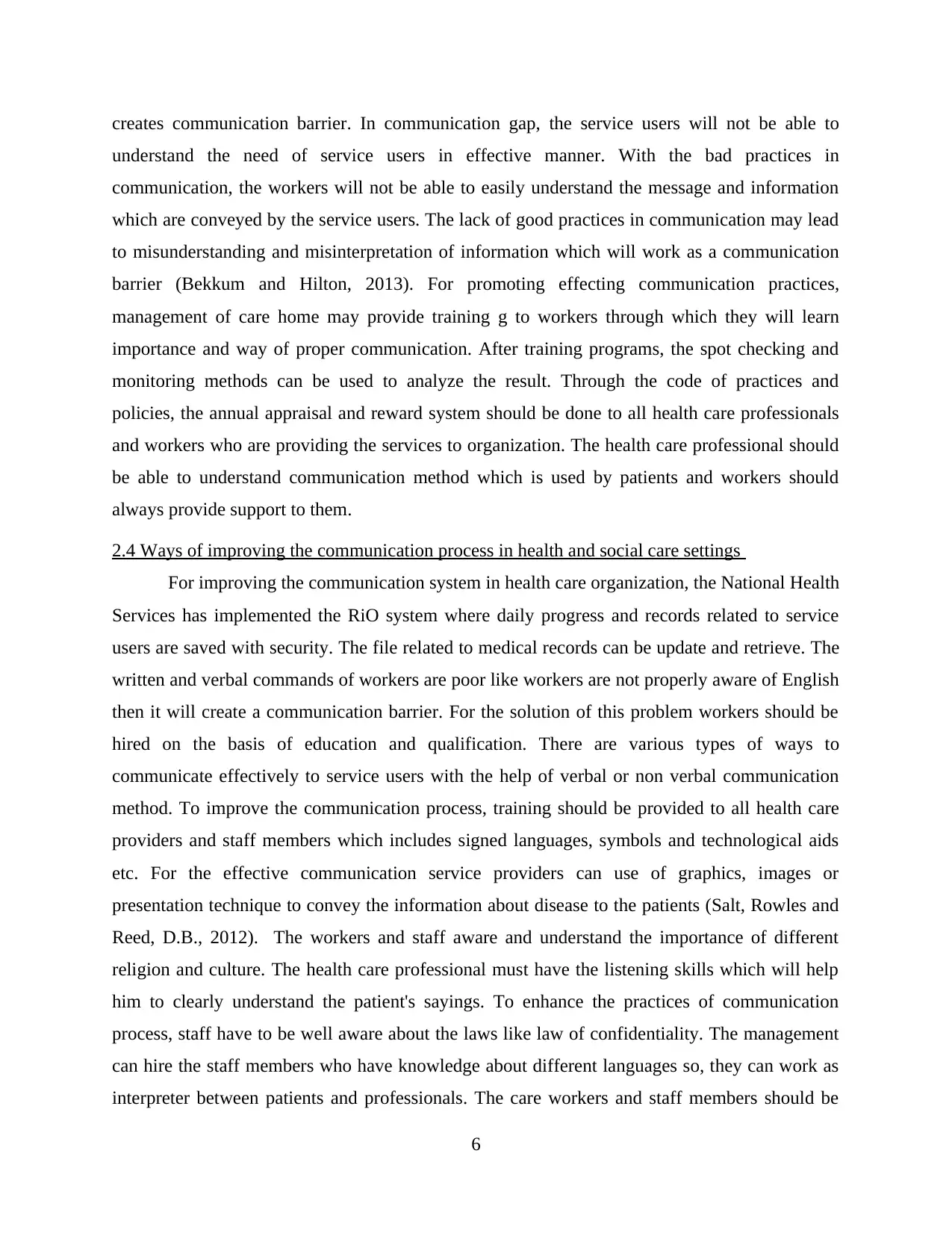
creates communication barrier. In communication gap, the service users will not be able to
understand the need of service users in effective manner. With the bad practices in
communication, the workers will not be able to easily understand the message and information
which are conveyed by the service users. The lack of good practices in communication may lead
to misunderstanding and misinterpretation of information which will work as a communication
barrier (Bekkum and Hilton, 2013). For promoting effecting communication practices,
management of care home may provide training g to workers through which they will learn
importance and way of proper communication. After training programs, the spot checking and
monitoring methods can be used to analyze the result. Through the code of practices and
policies, the annual appraisal and reward system should be done to all health care professionals
and workers who are providing the services to organization. The health care professional should
be able to understand communication method which is used by patients and workers should
always provide support to them.
2.4 Ways of improving the communication process in health and social care settings
For improving the communication system in health care organization, the National Health
Services has implemented the RiO system where daily progress and records related to service
users are saved with security. The file related to medical records can be update and retrieve. The
written and verbal commands of workers are poor like workers are not properly aware of English
then it will create a communication barrier. For the solution of this problem workers should be
hired on the basis of education and qualification. There are various types of ways to
communicate effectively to service users with the help of verbal or non verbal communication
method. To improve the communication process, training should be provided to all health care
providers and staff members which includes signed languages, symbols and technological aids
etc. For the effective communication service providers can use of graphics, images or
presentation technique to convey the information about disease to the patients (Salt, Rowles and
Reed, D.B., 2012). The workers and staff aware and understand the importance of different
religion and culture. The health care professional must have the listening skills which will help
him to clearly understand the patient's sayings. To enhance the practices of communication
process, staff have to be well aware about the laws like law of confidentiality. The management
can hire the staff members who have knowledge about different languages so, they can work as
interpreter between patients and professionals. The care workers and staff members should be
6
understand the need of service users in effective manner. With the bad practices in
communication, the workers will not be able to easily understand the message and information
which are conveyed by the service users. The lack of good practices in communication may lead
to misunderstanding and misinterpretation of information which will work as a communication
barrier (Bekkum and Hilton, 2013). For promoting effecting communication practices,
management of care home may provide training g to workers through which they will learn
importance and way of proper communication. After training programs, the spot checking and
monitoring methods can be used to analyze the result. Through the code of practices and
policies, the annual appraisal and reward system should be done to all health care professionals
and workers who are providing the services to organization. The health care professional should
be able to understand communication method which is used by patients and workers should
always provide support to them.
2.4 Ways of improving the communication process in health and social care settings
For improving the communication system in health care organization, the National Health
Services has implemented the RiO system where daily progress and records related to service
users are saved with security. The file related to medical records can be update and retrieve. The
written and verbal commands of workers are poor like workers are not properly aware of English
then it will create a communication barrier. For the solution of this problem workers should be
hired on the basis of education and qualification. There are various types of ways to
communicate effectively to service users with the help of verbal or non verbal communication
method. To improve the communication process, training should be provided to all health care
providers and staff members which includes signed languages, symbols and technological aids
etc. For the effective communication service providers can use of graphics, images or
presentation technique to convey the information about disease to the patients (Salt, Rowles and
Reed, D.B., 2012). The workers and staff aware and understand the importance of different
religion and culture. The health care professional must have the listening skills which will help
him to clearly understand the patient's sayings. To enhance the practices of communication
process, staff have to be well aware about the laws like law of confidentiality. The management
can hire the staff members who have knowledge about different languages so, they can work as
interpreter between patients and professionals. The care workers and staff members should be
6
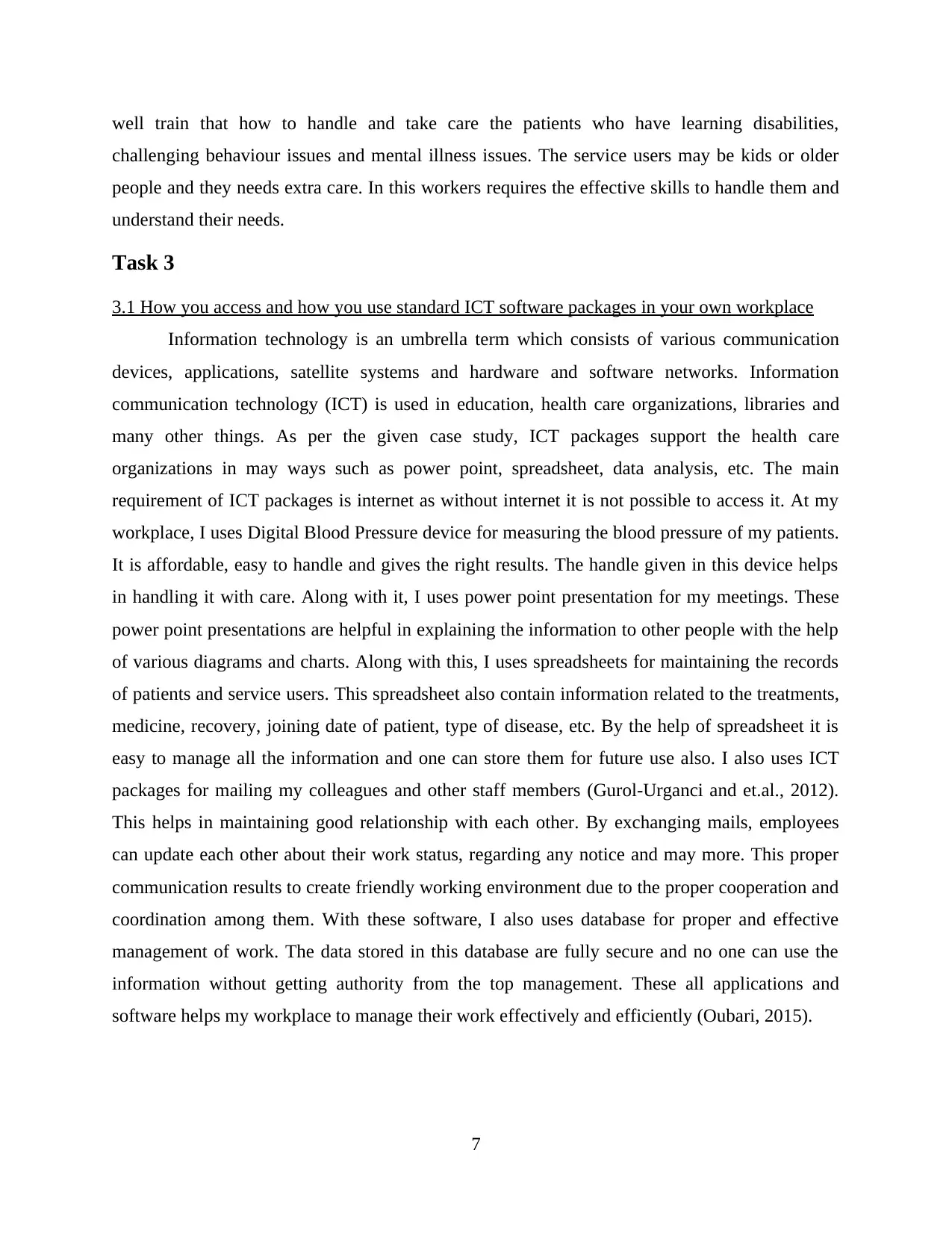
well train that how to handle and take care the patients who have learning disabilities,
challenging behaviour issues and mental illness issues. The service users may be kids or older
people and they needs extra care. In this workers requires the effective skills to handle them and
understand their needs.
Task 3
3.1 How you access and how you use standard ICT software packages in your own workplace
Information technology is an umbrella term which consists of various communication
devices, applications, satellite systems and hardware and software networks. Information
communication technology (ICT) is used in education, health care organizations, libraries and
many other things. As per the given case study, ICT packages support the health care
organizations in may ways such as power point, spreadsheet, data analysis, etc. The main
requirement of ICT packages is internet as without internet it is not possible to access it. At my
workplace, I uses Digital Blood Pressure device for measuring the blood pressure of my patients.
It is affordable, easy to handle and gives the right results. The handle given in this device helps
in handling it with care. Along with it, I uses power point presentation for my meetings. These
power point presentations are helpful in explaining the information to other people with the help
of various diagrams and charts. Along with this, I uses spreadsheets for maintaining the records
of patients and service users. This spreadsheet also contain information related to the treatments,
medicine, recovery, joining date of patient, type of disease, etc. By the help of spreadsheet it is
easy to manage all the information and one can store them for future use also. I also uses ICT
packages for mailing my colleagues and other staff members (Gurol‐Urganci and et.al., 2012).
This helps in maintaining good relationship with each other. By exchanging mails, employees
can update each other about their work status, regarding any notice and may more. This proper
communication results to create friendly working environment due to the proper cooperation and
coordination among them. With these software, I also uses database for proper and effective
management of work. The data stored in this database are fully secure and no one can use the
information without getting authority from the top management. These all applications and
software helps my workplace to manage their work effectively and efficiently (Oubari, 2015).
7
challenging behaviour issues and mental illness issues. The service users may be kids or older
people and they needs extra care. In this workers requires the effective skills to handle them and
understand their needs.
Task 3
3.1 How you access and how you use standard ICT software packages in your own workplace
Information technology is an umbrella term which consists of various communication
devices, applications, satellite systems and hardware and software networks. Information
communication technology (ICT) is used in education, health care organizations, libraries and
many other things. As per the given case study, ICT packages support the health care
organizations in may ways such as power point, spreadsheet, data analysis, etc. The main
requirement of ICT packages is internet as without internet it is not possible to access it. At my
workplace, I uses Digital Blood Pressure device for measuring the blood pressure of my patients.
It is affordable, easy to handle and gives the right results. The handle given in this device helps
in handling it with care. Along with it, I uses power point presentation for my meetings. These
power point presentations are helpful in explaining the information to other people with the help
of various diagrams and charts. Along with this, I uses spreadsheets for maintaining the records
of patients and service users. This spreadsheet also contain information related to the treatments,
medicine, recovery, joining date of patient, type of disease, etc. By the help of spreadsheet it is
easy to manage all the information and one can store them for future use also. I also uses ICT
packages for mailing my colleagues and other staff members (Gurol‐Urganci and et.al., 2012).
This helps in maintaining good relationship with each other. By exchanging mails, employees
can update each other about their work status, regarding any notice and may more. This proper
communication results to create friendly working environment due to the proper cooperation and
coordination among them. With these software, I also uses database for proper and effective
management of work. The data stored in this database are fully secure and no one can use the
information without getting authority from the top management. These all applications and
software helps my workplace to manage their work effectively and efficiently (Oubari, 2015).
7
⊘ This is a preview!⊘
Do you want full access?
Subscribe today to unlock all pages.

Trusted by 1+ million students worldwide
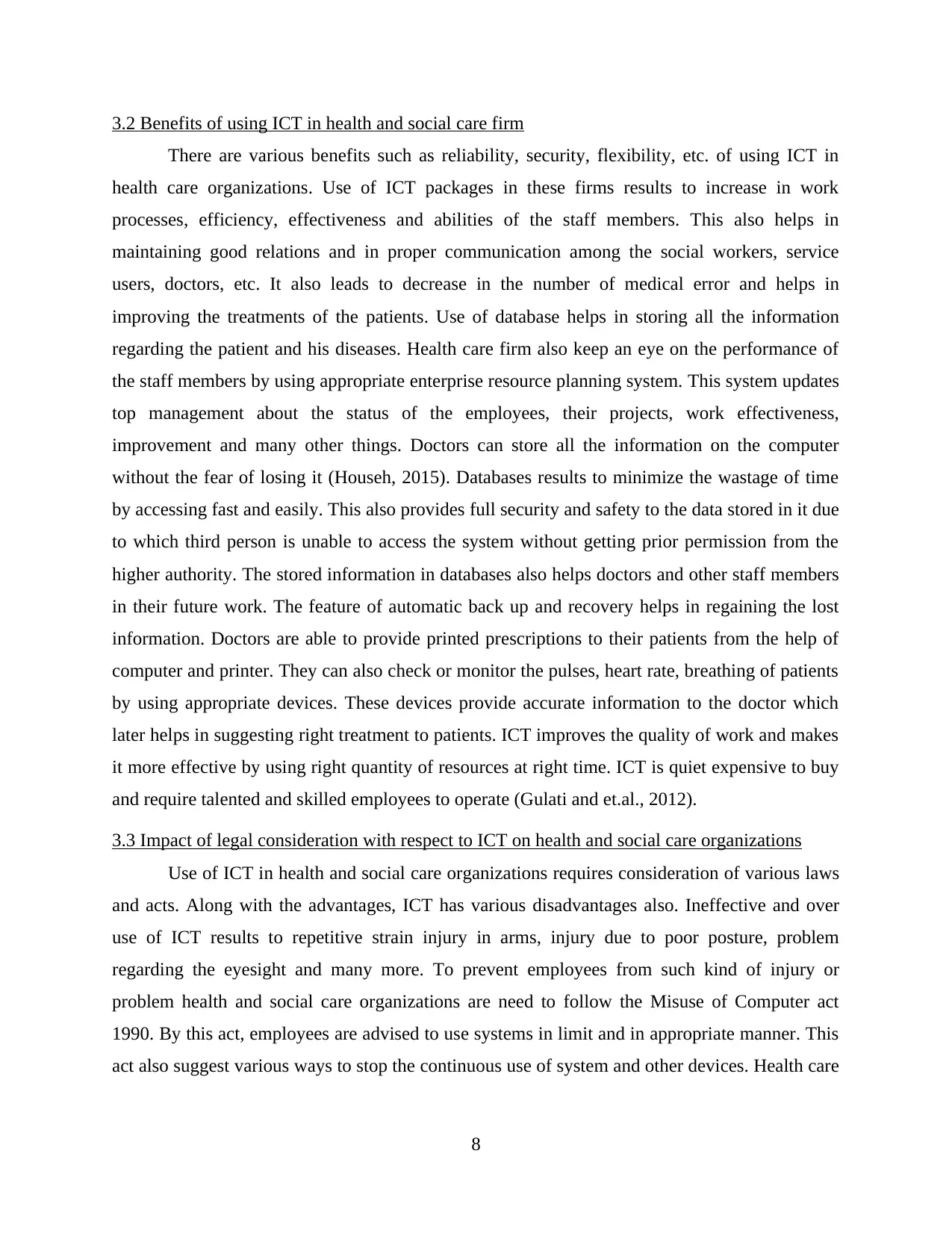
3.2 Benefits of using ICT in health and social care firm
There are various benefits such as reliability, security, flexibility, etc. of using ICT in
health care organizations. Use of ICT packages in these firms results to increase in work
processes, efficiency, effectiveness and abilities of the staff members. This also helps in
maintaining good relations and in proper communication among the social workers, service
users, doctors, etc. It also leads to decrease in the number of medical error and helps in
improving the treatments of the patients. Use of database helps in storing all the information
regarding the patient and his diseases. Health care firm also keep an eye on the performance of
the staff members by using appropriate enterprise resource planning system. This system updates
top management about the status of the employees, their projects, work effectiveness,
improvement and many other things. Doctors can store all the information on the computer
without the fear of losing it (Househ, 2015). Databases results to minimize the wastage of time
by accessing fast and easily. This also provides full security and safety to the data stored in it due
to which third person is unable to access the system without getting prior permission from the
higher authority. The stored information in databases also helps doctors and other staff members
in their future work. The feature of automatic back up and recovery helps in regaining the lost
information. Doctors are able to provide printed prescriptions to their patients from the help of
computer and printer. They can also check or monitor the pulses, heart rate, breathing of patients
by using appropriate devices. These devices provide accurate information to the doctor which
later helps in suggesting right treatment to patients. ICT improves the quality of work and makes
it more effective by using right quantity of resources at right time. ICT is quiet expensive to buy
and require talented and skilled employees to operate (Gulati and et.al., 2012).
3.3 Impact of legal consideration with respect to ICT on health and social care organizations
Use of ICT in health and social care organizations requires consideration of various laws
and acts. Along with the advantages, ICT has various disadvantages also. Ineffective and over
use of ICT results to repetitive strain injury in arms, injury due to poor posture, problem
regarding the eyesight and many more. To prevent employees from such kind of injury or
problem health and social care organizations are need to follow the Misuse of Computer act
1990. By this act, employees are advised to use systems in limit and in appropriate manner. This
act also suggest various ways to stop the continuous use of system and other devices. Health care
8
There are various benefits such as reliability, security, flexibility, etc. of using ICT in
health care organizations. Use of ICT packages in these firms results to increase in work
processes, efficiency, effectiveness and abilities of the staff members. This also helps in
maintaining good relations and in proper communication among the social workers, service
users, doctors, etc. It also leads to decrease in the number of medical error and helps in
improving the treatments of the patients. Use of database helps in storing all the information
regarding the patient and his diseases. Health care firm also keep an eye on the performance of
the staff members by using appropriate enterprise resource planning system. This system updates
top management about the status of the employees, their projects, work effectiveness,
improvement and many other things. Doctors can store all the information on the computer
without the fear of losing it (Househ, 2015). Databases results to minimize the wastage of time
by accessing fast and easily. This also provides full security and safety to the data stored in it due
to which third person is unable to access the system without getting prior permission from the
higher authority. The stored information in databases also helps doctors and other staff members
in their future work. The feature of automatic back up and recovery helps in regaining the lost
information. Doctors are able to provide printed prescriptions to their patients from the help of
computer and printer. They can also check or monitor the pulses, heart rate, breathing of patients
by using appropriate devices. These devices provide accurate information to the doctor which
later helps in suggesting right treatment to patients. ICT improves the quality of work and makes
it more effective by using right quantity of resources at right time. ICT is quiet expensive to buy
and require talented and skilled employees to operate (Gulati and et.al., 2012).
3.3 Impact of legal consideration with respect to ICT on health and social care organizations
Use of ICT in health and social care organizations requires consideration of various laws
and acts. Along with the advantages, ICT has various disadvantages also. Ineffective and over
use of ICT results to repetitive strain injury in arms, injury due to poor posture, problem
regarding the eyesight and many more. To prevent employees from such kind of injury or
problem health and social care organizations are need to follow the Misuse of Computer act
1990. By this act, employees are advised to use systems in limit and in appropriate manner. This
act also suggest various ways to stop the continuous use of system and other devices. Health care
8
Paraphrase This Document
Need a fresh take? Get an instant paraphrase of this document with our AI Paraphraser
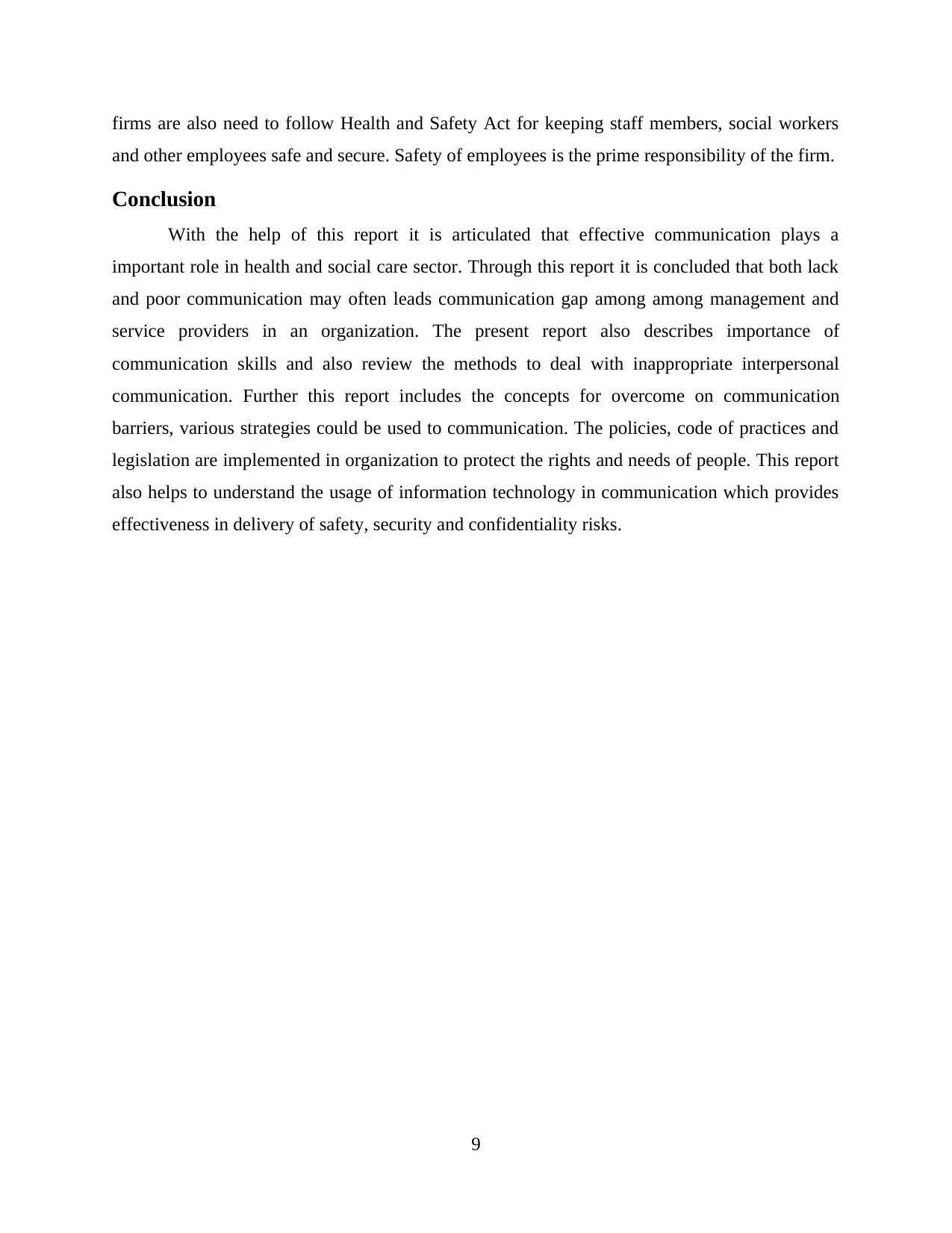
firms are also need to follow Health and Safety Act for keeping staff members, social workers
and other employees safe and secure. Safety of employees is the prime responsibility of the firm.
Conclusion
With the help of this report it is articulated that effective communication plays a
important role in health and social care sector. Through this report it is concluded that both lack
and poor communication may often leads communication gap among among management and
service providers in an organization. The present report also describes importance of
communication skills and also review the methods to deal with inappropriate interpersonal
communication. Further this report includes the concepts for overcome on communication
barriers, various strategies could be used to communication. The policies, code of practices and
legislation are implemented in organization to protect the rights and needs of people. This report
also helps to understand the usage of information technology in communication which provides
effectiveness in delivery of safety, security and confidentiality risks.
9
and other employees safe and secure. Safety of employees is the prime responsibility of the firm.
Conclusion
With the help of this report it is articulated that effective communication plays a
important role in health and social care sector. Through this report it is concluded that both lack
and poor communication may often leads communication gap among among management and
service providers in an organization. The present report also describes importance of
communication skills and also review the methods to deal with inappropriate interpersonal
communication. Further this report includes the concepts for overcome on communication
barriers, various strategies could be used to communication. The policies, code of practices and
legislation are implemented in organization to protect the rights and needs of people. This report
also helps to understand the usage of information technology in communication which provides
effectiveness in delivery of safety, security and confidentiality risks.
9
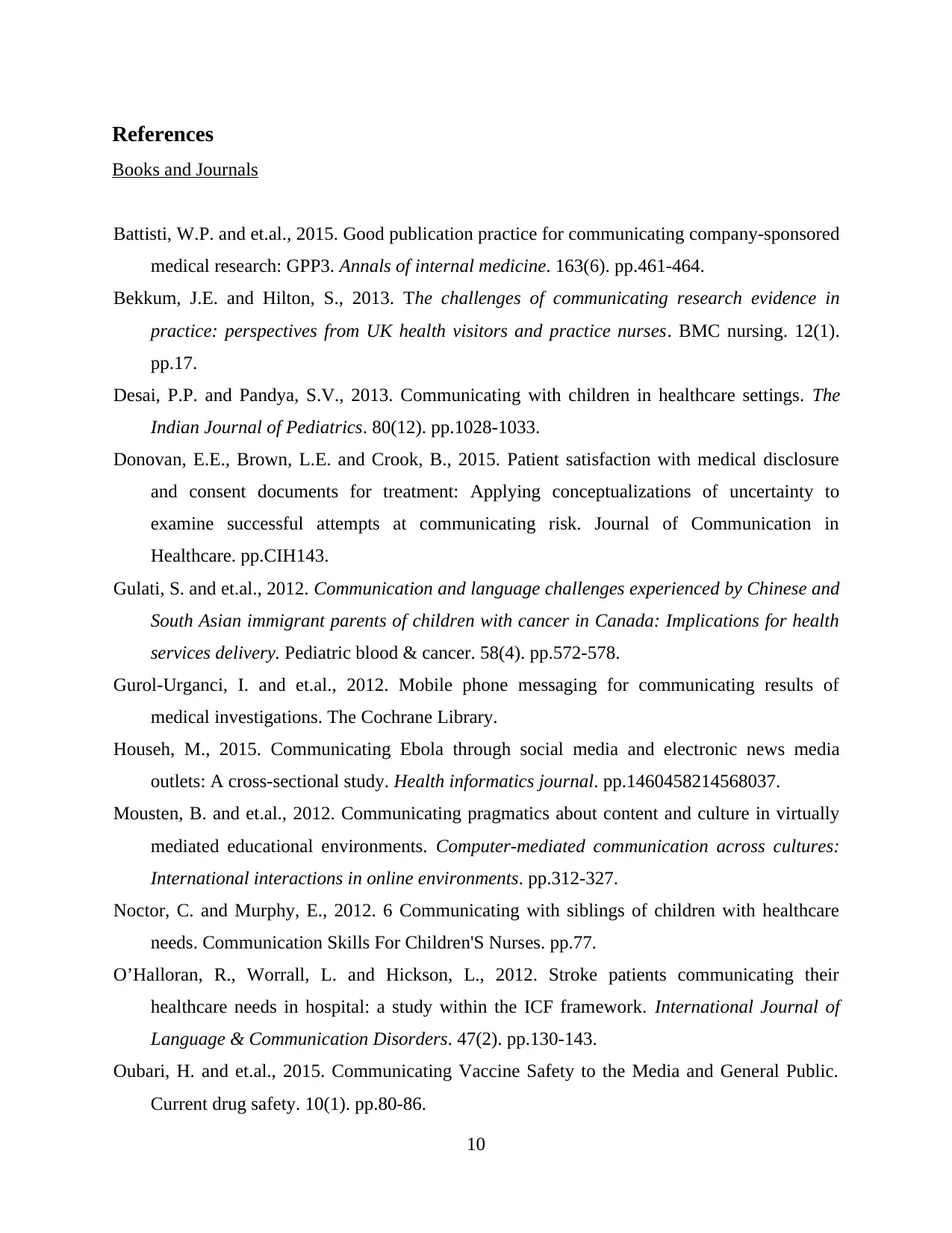
References
Books and Journals
Battisti, W.P. and et.al., 2015. Good publication practice for communicating company-sponsored
medical research: GPP3. Annals of internal medicine. 163(6). pp.461-464.
Bekkum, J.E. and Hilton, S., 2013. The challenges of communicating research evidence in
practice: perspectives from UK health visitors and practice nurses. BMC nursing. 12(1).
pp.17.
Desai, P.P. and Pandya, S.V., 2013. Communicating with children in healthcare settings. The
Indian Journal of Pediatrics. 80(12). pp.1028-1033.
Donovan, E.E., Brown, L.E. and Crook, B., 2015. Patient satisfaction with medical disclosure
and consent documents for treatment: Applying conceptualizations of uncertainty to
examine successful attempts at communicating risk. Journal of Communication in
Healthcare. pp.CIH143.
Gulati, S. and et.al., 2012. Communication and language challenges experienced by Chinese and
South Asian immigrant parents of children with cancer in Canada: Implications for health
services delivery. Pediatric blood & cancer. 58(4). pp.572-578.
Gurol‐Urganci, I. and et.al., 2012. Mobile phone messaging for communicating results of
medical investigations. The Cochrane Library.
Househ, M., 2015. Communicating Ebola through social media and electronic news media
outlets: A cross-sectional study. Health informatics journal. pp.1460458214568037.
Mousten, B. and et.al., 2012. Communicating pragmatics about content and culture in virtually
mediated educational environments. Computer-mediated communication across cultures:
International interactions in online environments. pp.312-327.
Noctor, C. and Murphy, E., 2012. 6 Communicating with siblings of children with healthcare
needs. Communication Skills For Children'S Nurses. pp.77.
O’Halloran, R., Worrall, L. and Hickson, L., 2012. Stroke patients communicating their
healthcare needs in hospital: a study within the ICF framework. International Journal of
Language & Communication Disorders. 47(2). pp.130-143.
Oubari, H. and et.al., 2015. Communicating Vaccine Safety to the Media and General Public.
Current drug safety. 10(1). pp.80-86.
10
Books and Journals
Battisti, W.P. and et.al., 2015. Good publication practice for communicating company-sponsored
medical research: GPP3. Annals of internal medicine. 163(6). pp.461-464.
Bekkum, J.E. and Hilton, S., 2013. The challenges of communicating research evidence in
practice: perspectives from UK health visitors and practice nurses. BMC nursing. 12(1).
pp.17.
Desai, P.P. and Pandya, S.V., 2013. Communicating with children in healthcare settings. The
Indian Journal of Pediatrics. 80(12). pp.1028-1033.
Donovan, E.E., Brown, L.E. and Crook, B., 2015. Patient satisfaction with medical disclosure
and consent documents for treatment: Applying conceptualizations of uncertainty to
examine successful attempts at communicating risk. Journal of Communication in
Healthcare. pp.CIH143.
Gulati, S. and et.al., 2012. Communication and language challenges experienced by Chinese and
South Asian immigrant parents of children with cancer in Canada: Implications for health
services delivery. Pediatric blood & cancer. 58(4). pp.572-578.
Gurol‐Urganci, I. and et.al., 2012. Mobile phone messaging for communicating results of
medical investigations. The Cochrane Library.
Househ, M., 2015. Communicating Ebola through social media and electronic news media
outlets: A cross-sectional study. Health informatics journal. pp.1460458214568037.
Mousten, B. and et.al., 2012. Communicating pragmatics about content and culture in virtually
mediated educational environments. Computer-mediated communication across cultures:
International interactions in online environments. pp.312-327.
Noctor, C. and Murphy, E., 2012. 6 Communicating with siblings of children with healthcare
needs. Communication Skills For Children'S Nurses. pp.77.
O’Halloran, R., Worrall, L. and Hickson, L., 2012. Stroke patients communicating their
healthcare needs in hospital: a study within the ICF framework. International Journal of
Language & Communication Disorders. 47(2). pp.130-143.
Oubari, H. and et.al., 2015. Communicating Vaccine Safety to the Media and General Public.
Current drug safety. 10(1). pp.80-86.
10
⊘ This is a preview!⊘
Do you want full access?
Subscribe today to unlock all pages.

Trusted by 1+ million students worldwide
1 out of 13
Related Documents
Your All-in-One AI-Powered Toolkit for Academic Success.
+13062052269
info@desklib.com
Available 24*7 on WhatsApp / Email
![[object Object]](/_next/static/media/star-bottom.7253800d.svg)
Unlock your academic potential
Copyright © 2020–2025 A2Z Services. All Rights Reserved. Developed and managed by ZUCOL.



![Report: Communicating in Health and Social Care - [University]](/_next/image/?url=https%3A%2F%2Fdesklib.com%2Fmedia%2Fimages%2Fyr%2Fb306ef9318ba488aa62dd09a19211157.jpg&w=256&q=75)

